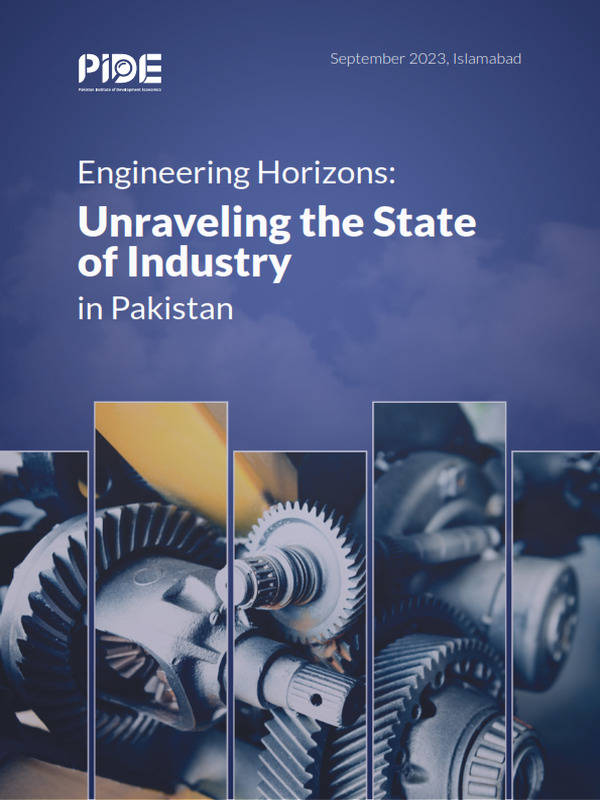
Pakistan Institute of Development Economics
- Home
Our Portals
MenuMenuMenuMenuMenuMenuMenu - ResearchMenuMenuMenuMenuMenuMenuMenu
- Discourse
- The PDR
- Our Researchers
- Academics
- Degree Verification
- Thesis Portal
- Our Portals
Engineering Horizons: Unraveling the State of Industry in Pakistan
Introduction
According to the Pakistan Institute of Development Economics, Pakistan’s long-term GDP or output growth is faltering at best and declining at worst (PIDE, 2021).
The economy’s structure, in terms of sectoral shares of GDP, indicates that the indus- trial sector is declining prematurely. In addition, indications are that productivity levels across various sectors of the economy are declining (Faraz et al., 2023).
Industrialization is a critical element of long-term economic growth and development, which can be expounded through various seminal economic theories (Cassen & Lall, 1996). Industrialization leads to increased productivity and efficiency, diversification of the economy, and improved living standards for citizens. These concepts are supported by various major economic theories, which underscore the significance of industrialization as a catalyst for economic growth and development.
To put the economy back on track for sustainable, long term equitable growth, it is necessary to assess the state of the industrial sector and identify the key issues that hinder its progress. An unstable policy environment has created problems for the sector in the country, as reflected in the recent closures of plants. Therefore, it is essential to analyze the nature of crises that the industry faces and to identify mea- sures essential to gain efficiency, which this study aims to do.
Such an analysis naturally requires data on the industrial sector, particularly the engi- neering industry, which is sparse and considered outdated. A case in point is the latest Census of Manufacturing Industries (CMI), conducted in 2015-16 and only released last year. There is no other readily available comprehensive dataset or report on the engineering industry in the country. It is difficult to devise effective policy interven- tions and proposals without research and the data required to undertake them. In contributing 12.4% to GDP and employing 14.9% of the economy’s labor force , the manufacturing sector has a vital role in the domestic economy (PES, 2022). Therefore, it warrants the attention of researchers and policymakers alike. Considering this fact, generating a snapshot of the industrial sector or undertaking a “deep dive” into a sub-sector, such as the engineering industry is advisable.
As part of the industrial sector, the engineering industry is a critical component of the economy with backward and forward linkages to other sectors of the economy. It fulfils the demand for its products in the economy and also creates a demand for inputs from the rest of the economy, as well as downstream economic activities. Thus, it has a significant impact on various industries, including manufacturing, construc- tion, and transportation. As such, it is an essential driver of economic growth and development (ACEC, 2020; PWC, 2020).
The engineering industry is at the forefront of rapid pace of technological change in the economy. This creates a growing demand for skilled workers who possess the nec- essary knowledge and expertise to operate and maintain complex equipment and systems (OECD, 2017). The development of new materials and manufacturing tech- niques has also led to significant improvements in the performance and efficiency of various infrastructure and systems, such as bridges, buildings, and transportation networks (Chen et al., 2021).
One of the major challenges facing the engineering industry is the rapid pace of tech- nological change. This has led to a growing demand for skilled workers with the neces- sary knowledge and expertise to operate and maintain complex equipment and systems (OECD, 2017). Developing new materials and manufacturing techniques has also led to significant improvements in the performance and efficiency of various infrastructures and systems, such as bridges, buildings, and transportation networks (Chen et al., 2021).
Technological advancements, such as automation and Artificial Intelligence (AI) in the engineering industry, are another area of significant interest. Research has shown that integrating AI technologies can help improve the efficiency and accuracy of vari- ous engineering processes, such as design, planning, and maintenance (Pan & Zhang, 2021). However, concerns have also been raised about the potential impact of auto- mation on employment and job security for workers in the engineering industry (Frey & Osborne, 2017).
In addition to technological change and advancements, the engineering industry is also influenced by broader economic and political factors. For example, the impact of global economic trends and geopolitical events can have a significant impact on the demand for engineering services and the availability of skilled labor (Engineering UK, 2021). Furthermore, regulatory frameworks and policies related to environmental protection and sustainability also play an increasingly important role in shaping the direction of the engineering industry (Mihelcic et al., 2003).
Pakistan’s engineering industry covers a broad range of activities, including civil, mechanical, electrical, and electronic engineering, among others (PCST, 2020). The industry faces significant challenges related to infrastructure challenges, lack of skilled labor, and limited R&D capabilities. However, there are also opportunities for growth and development in the sector, ranging from the country’s strategic location, availability of natural resources, and a young and growing population. These attri- butes can provide a solid foundation for the sector’s expansion, which can be realized through continued investment in education and training, R&D, and the development of new technologies and processes.
Considering the discussion above, several areas need to be explored in depth in the engineering sector of Pakistan, and this research is only possible if a survey of engi- neering firms is conducted. This detailed report covering a range of key areas related to the engineering industry provides evidence-based policy interventions for enhanc- ing the competitiveness and export potential of the industry in Pakistan.



